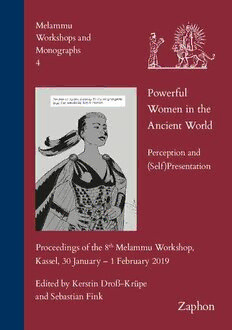
Powerful Women in the Ancient World: Perception and (Self) Presentation: Proceedings of the 8th Melammu Workshop, Kassel, 30 January - 1 February 2019 (Melammu Workshops and Monographs, 4) PDF
588 Pages·2021·6.222 MB·English
Most books are stored in the elastic cloud where traffic is expensive. For this reason, we have a limit on daily download.
Preview Powerful Women in the Ancient World: Perception and (Self) Presentation: Proceedings of the 8th Melammu Workshop, Kassel, 30 January - 1 February 2019 (Melammu Workshops and Monographs, 4)
Description:
The present volume focuses on powerful women in the ancient world and not only taking an exceptionally broad temporal and geographical scope, but also combining contributions on the portrayal of powerful ancient women in cuneiform texts and classical sources. In doing so, it aims at bringing together both a "western" and "eastern" perspective on the remembrance of these exceptional women and likewise at making the Self-presentation of these women as well as their discursive/narrative treatment by (later, male) outsiders the centre of attention. Power is understood in its broadest sense - not only real political and formal power, but also more informal concepts of power, such as relations of dependence and superiority in private, in the religious or economic spheres, taking into account that the latter forms of power can nevertheless influence the exercise of formal power. Thus, both actual female rulers and women who pulled strings from behind the scenes - at least according to their presentation in the sources - are gathered here. The key questions the contributors to this volume ask are: What information does a close and critical reading of the available sources provide about their actual radius of action and their social and economic status? Were these women considered role models (and if so when and by whom)? What do these details tell us about different gender roles in the Classical and Mesopotamian worlds? How (and possibly why) where the attitudes towards women different? In particular, the contributions focus on Innana, Enheduana, and Shamhat from the Ancient Near East, Hatshepsut and Amanishakheto from Egypt, Bathsheba, female prophets, and women at the heart of the tribal system from the Biblical World, and Ada, Antigone, Cleopatra, Cornelia, Elpinice, Iulia maior, Julia Domna, Livia, Messalina, Olympias, Shirin, Valeria Melania, and Zenobia of Palmyra in classical and modern sources.
See more
The list of books you might like
Most books are stored in the elastic cloud where traffic is expensive. For this reason, we have a limit on daily download.
